|
|
Pharamond II

|
|
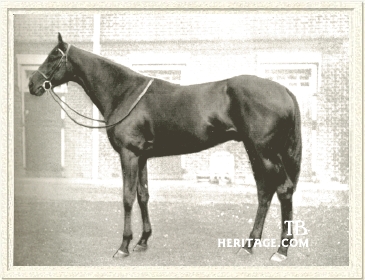 |
|
|
Pharamond II was the second foal out of his dam, Selene, and a full brother to that mare's first foal, the year-older Sickle, who became a two-time Leading Sire in the United States. A good two-year-old, Pharamond II became one of the leading sires in the U.S., and his male line lives on through his great grandson Buckpasser, and in more modern times through Kentucky Derby winners Spend A Buck, Lil E. Tee, and Silver Charm.
Pharamond II was born on the 17 of January, 1925, in the same Stanley House Stud foal crop as Fairway, the little brother to Pharos. Like those two, and his brother Sickle, Pharamond II was bred on the same Phalaris/Chaucer cross. A small horse like his dam, and similar in type to Phalaris, Pharamond II was blockier than Sickle and less perfectly made, a little upright in his shoulder and pasterns, a little light below the knee, a shorter, thicker neck, and slightly sickle-hocked.
Pharamond on the Turf
Trained by George Lambton for Lord Derby, Pharamond II was a good two-year-old, although perhaps not in the same high class as Sickle had been. Fairway was always the stable's darling, and Pharamond II at least twice served as a substitute for the star during his racing career. He ran six times at two, running unplaced as an inexperienced debutante in the Zetland Plate (York) in May against 14 others. In his second start, at the Royal Ascot meeting, he was third in the Windsor Castle Stakes behind Sunny Trace and Three Star, with the future 2,000 Guineas winner Flamingo behind him in fourth. In the National Breeders' Produce Stakes (5f. Newmarket), Pharamond II was made favorite, but finished unplaced behind the easy winner, Flamingo in a field of 21.
Against only five in the Lancashire Breeders' Produce Stakes (Liverpool), Pharamond II could not successfully give Dark Doll 15 pounds, and lost by a neck. In the Buckenham Produce Stakes (Newmarket), he went off as the favorite in the small field of three, but went down by a short head to The Wheedler. Stablemate Fairway had been slated to start in the Middle Park Stakes (6f. Newmarket) but came up lame after his win in the Champagne Stakes, so Pharamond II made the engagement in his stead. Luckily, the field came up weak, and Pharamond II broke his maiden and finished the season in style, winning by a head over Parwiz (later a good handicapper and an important sire in Argentina), who finished a short head in front of the filly Maer Hills. On the Free Handicap, Pharamond II was rated 110 pounds, far below the class leaders Fairway, Hermit II and Buland, who were joint-highweights at 126 pounds, with Flamingo and Gang Warily at 122 pounds.
Frank Butters took over the training of the Derby string in 1928, but had little success with Pharamond II at three. His season debut was in the Nonsuch Stakes at Epsom in April, in which he was unplaced. When Fairway was forced out of the 2,000 Guineas as a result of mouth abcesses, Pharamond II was trotted up as his replacement. The little colt actually made a brave showing, and in a furious finish, was fourth behind the winner Flamingo, who won by a head over Royal Minstrel, one and a half lengths in front of O'Curry, who was a head in front of Pharamond II.
Fairway went on to blow the Derby (won by Felstead) but regained his reputation with a win in the St. Leger. Pharamond II, instead, tailed off. In the Kempton Park Great Jubilee Handicap, with the feather weight of 100 pounds, he ran a bad race, out of the top three in a race won by Abbot's Speed. In the St. James's Palace Stakes at Royal Ascot, he was unplaced behind Royal Minstrel, but vindicated himself in his final start, the Ellesmere Stakes (13f.), which, as starting favorite, he won by a neck in a field of three, carrying just 103 pounds. He retired from racing with just a pair of wins from 11 starts (and £3,695), although one of those was the valuable Middle Park Stakes at two.
Pharamond in the Stud
Owning Phalaris, Pharos, Fairway, and the better brother in Sickle, Lord Derby put Pharamond II up for sale with the British Bloodstock Agency, priced at £10,000 ($50,000). Kentuckian Hal Price Headley came to England to inspect the colt. As he related to Abe Hewitt (in Sire Lines), "it was practically dark when he arrived on a gloomy evening in the late autumn or early winter and that Pharamond II barely was discernible where he stood in straw nearly up to his knees and in a barn covered with black tar paint. Headley did not ask to have Pharamond II brought out because as he put it, 'I did not want Lord Derby's men to learn how interested I was."
Headley offered £4,000 on behalf of a small syndicate of Americans (Headley, Robert M. Eastman, and C.J. FitzGerald), which was accepted, and Pharamond II arrived to stand at Headley's Beaumont Farm on the western edge of Lexington, Kentucky for the 1929 season. (His brother Sickle entered stud in England the same year, and came to Lexington the following year.) In 1932, the syndicate was dissolved, and Headley purchased Pharamond II outright for $7,500. This proved a real coup for Headley, who subsequently enjoyed tremendous success with the stallion, sire of 399 foals and 35 stakes winners.
Pharamond II's first crop produced little of note, which may have been why the syndicate failed. The second crop produced his first stakes winner, the good juvenile filly High Glee, and the stakes winners kept coming. Pharamond II was the second Leading Sire in 1938 (behind his brother Sickle), and was among the top five in 1937, 1943, and 1944. Although he tended to throw a phenotype for precocious speed like his own, several of his best runners were excellent middle distance runners and stayers.
His first good winner, HIGH GLEE (f. 1931 out of Beaming by Whisk Broom II), was bred by C.V. Whitney, out of a daughter of Masda, a sister to Man O'War. High Glee forged her own reputation as one of the best fillies in training at two, winning the Troy Claiming Stakes and Matron Stakes, and placing in the Pimlico Nursery Stakes, Hialeah Juvenile Championship Stakes and Nursery Stakes No.2. She returned at three to win the Blackstone Valley Handicap, Green Mountain Handicap, and Christmas Stakes, placed in six other stakes, including the Toboggan Handicap, when third versus the nation's best sprinters. High Glee was stakes-placed at four and five, but never regained her classy form, retiring with nine wins from 48 starts and $49,050. As a broodmare, High Glee produced the stakes-winning filly Bright Song (by Carrier Pigeon), and stakes-placed gelding High Peak (by Omaha) from six foals.
|
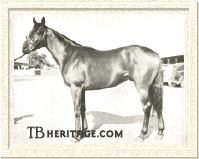
Menow |
|
Pharamond II's best runner, however, was MENOW (dk.b.c. 1935 out of Alcibiades by Supremus), a Headley homebred out of the champion two-year-old filly Alcibiades. Named for the Headley children's pleas for attention ("Me now!") Alcibiades' foal was a May 19 baby, but came into hand early for a championship juvenile campaign. Winning half of six starts, he was second in his debut at Washington Park, when inexperience and a sloppy track were reasonable excuses in the two-length defeat. He won his second start by a neck over Pharacase (also by Pharamond II), then was second to Tiger in the Washington Park Futurity (6f.). After an uncharacteristically poor unplaced effort in the Arlington Futurity, he was rested, but returned to win the Champagne Stakes by four lengths from Bull Lea, although favorite Sky Larking broke down in mid-stretch. |
Menow's performance in the Futurity was spectacular, running off to win by four from Tiger and Fighting Fox, in a new world record for the six and a half furlongs (1:15 1/5) down the straight course of the Widener chute, breaking the old record by over a second. Menow was voted Champion Two-Year-Old Male and was highweight on the Experimental Free Handicap with 126 pounds, with Tiger second at 125.
At three, Menow returned for four wins in 11 starts. He scored in his debut (6f.) at Keeneland in April, then was second to Bull Lea, who set a new track record at the same track for a mile and a sixteenth in a prep race. In the Blue Grass Stakes, Menow again lost to Bull Lea by a neck, although his pace had forced another track record, for nine furlongs. Third in the Kentucky Derby (to Lawrin and Dauber, with Bull Lea unplaced) after setting the pace, Menow was third in the Preakness (to Dauber and Cravat). Dropped back in distance, he won the Withers Stakes (8f.) with ease. In the Massachusetts Handicap (9f.) on a muddy track, Menow led throughout to win by eight lengths, beating the older champion War Admiral, who conceded him 27 pounds. In the Arlington Classic (10f.), Menow fizzled after setting the pace in a race won by Nedayr, Bull Lea second. Fourth in the Jerome Handicap (8f.), he bounced back to win the Potomac Handicap (8.5f. Havre de Grace), beating nemesis Bull Lea. In the Havre de Grace Handicap, Menow set the pace for Seabiscuit, but finished third, having bowed in both forelegs.
Menow retired with seven wins in 17 starts and $140,100. He could carry his front-running speed to nine furlongs under the right conditions, (he loved a wet track), and rarely ran a poor race. Menow typified the progeny of Pharamond II, being a tremendously muscled, rugged sort who came into hand early and showed brilliant speed. Menow was better made than his sire, however, being a larger horse, but with shorter cannons and a straighter hind leg. He entered stud at Beaumont Farm in 1939 alongside his sire and was quite a success, getting 32 stakes winners, including champions Tom Fool, Capot, and Askmenow, as well as the good gelding Ruhe, Letmenow, and Megogo, all earners of over $100,000.
|
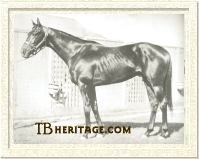
By Jimminy |
|
Bred by E.R. Bradley's Idle Hour Stock Farm, Pharamond II's son BY JIMMINY (br.c. 1941 out of Buginarug by Blue Larkspur) was a full brother in blood to Saranac Handicap winner Bless Me, his older half-brother (by Sickle). Racing for A.P. Parker, at two, By Jimminy won the Grand Union Hotel Stakes at Saratoga, and was second in the Pimlico Futurity (to division champion Platter) and Albany Handicap, and third in the Hopeful Stakes and Richard Johnson Stakes. At three, he was the best male of his age in a division dominated by the filly Twilight Tear. Unusual for his sire, By Jimminy bloomed as the distances got longer. He won the Dwyer Stakes, American Derby, Lawrence Realization, Travers Stakes, Shevlin Stakes, and was second in the Withers and third in the Empire City Stakes. |
| By Jimminy wasn't a terrific success as a sire with just three stakes winners, but one of those was Bold (Preakness and Saranac Handicap), and his daughter Highland Fling produced the champion Sword Dancer, a terrific stayer and sire of champions Damascus and Lady Pitt.
|
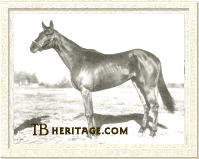
Apogee
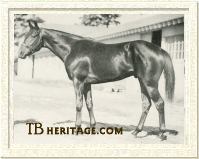
Cosmic Bomb |
|
APOGEE (b.f. 1934 out of Summit by Ultimus) was also bred by Hal Price Headley. Champion filly at two, the only year she raced, Apogee made nine starts and won three including the Arlington Lassie Stakes, Old Colony Stakes (setting a new track record at Narragansett) and Fashion Stakes. She was also second in the Hyde Park Stakes and Juvenile Stakes, and third in the Arlington Futurity. As a broodmare, Apogee produced three stakes winners, Flood Town (1942 c. by Johnstown), Acoma (1946 f. by Johnstown), and Sofarsogood (1952 f. by Revoked), the latter two also being stakes winners only at two.
COSMIC BOMB (dk.b.c. 1944 out of Banish Fear by Blue Larkspur) was bred by John D. Hertz and sold as a yearling for $29,500 to William Helis. He won half of ten starts at two including the Arlington Futurity (over Jet Pilot, Colonel O'F.) and Cowdin Stakes (over Colonel O'F, Branbancon), also third in the Hyde Park Stakes. He was disqualified from second in the Hopeful Stakes after his jockey held the saddle cloth of Blue Border, the winner by a nose. Cosmic Bomb was co-highweight on the Experimental Free Handicap with the voted champion Double Jay and filly champion First Flight, all at 126 pounds. |
Although built like a sprinter with a terrific hindquarter so common for his sireline, like the previously mentioned By Jimminy, Cosmic Bomb grew into a top class middle distance runner once he got past a disappointing sophomore spring. From 16 starts, he won six, the best of which was the Lawrence Realization (13f.) by a head over division leader Phalanx. He also won the Drexel (8f.), Discovery (9f. beating Phalanx and Double Jay), Trenton (9f. by five lengths in new track record time), and Roamer Handicaps. His seconds included the American Derby (to Fervent by a neck in track record time), Jerome Handicap, Pimlico Special, and thirds in the Arlington Classic and Derby Trial. He was considered one of the best of the four top colts of the crop. Unraced at four, Cosmic Bomb made one start at five, in which he finished second, then was retired with 11 wins in 27 starts and $248,890.
Cosmic Bomb was a useful sire, with 11 stakes winners led by the good colt Federal Hill, but his main claim to fame is as the sire of stakes-winning filly Cosmah, who earned fame as the dam of a brood that included champion Tosmah, the leading sire Halo, Fathers Image, Maribeau (sire), and Queen Sucree (dam of Kentucky Derby winner Cannonade, granddam of Stephan's Oddessy, Lotka)..
|
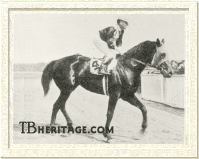
Whopper
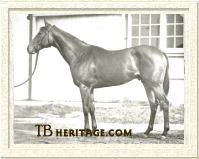
King Cole |
|
Like Menow, WHOPPER (b.g. 1932 out of Romance by Luke McLuke) was a homebred for Beaumont Farm's Hal Price Headley and rewarded him accordingly. A very big, heavily muscled horse, his name betrayed his appearance. Unraced at two, he ran 54 times from three to five, winning 18 races and earning $80,270. At three, he won the Agawam and Blackstone Valley Handicaps, and placed second or third in eight stakes including the Massachusetts Handicap. At four, he won the San Juan Capistrano Handicap, a staying test, plus the Ponchartrain and Inaugural Handicaps, besides placing in five stakes including the Metropolitan and Suburban Handicaps. At five, he won five stakes including the Philadelphia, Jamaica, Col. Alger Memorial, Wolverine, and Hialeah Park Inaugural Handicaps.
KING COLE (b.c. 1938 out of Golden Melody by Mont d'Or II) was bred by the prominent veterinarian Dr. Charles E. Hagyard, and sold at Saratoga as a yearling to Ogden Phipps for $6,500. His dam was a daughter of Ormonda, so he was closely related to Brevity and Reaping Reward, from this same family but by Pharamond II's brother Sickle. |
Unlike the typical Pharamond II, this one was built along greyhound lines, tall and leggy and short backed. One of the better juveniles of his year, King Cole won four of nine starts but made his reputation while prepping for the Futurity Stakes, wiring his field in the Babylon Handicap (6f.) to win by seven equaling the track record, and Junior Champion Stakes (6.5f.) in which he led throughout setting blistering fractions and notched another a new track record (1:17) while winning by two and a quarter lengths over filly champion Level Best. King Cole was second in the Futurity to Our Boots after tiring in the stretch and second also in the Old Colony Stakes.
At three, King Cole made eight starts and won three, the Withers Stakes, Shevlin Stakes, and Paumonok Handicap. He was also second in the Preakness (to Whirlaway), Roseben Handicap, Swift Stakes, and third in the Wood Memorial and Peter Pan Handicap. He retired with seven wins in 17 starts and $74,250. At stud, King Cole sired seven stakes winners, but nothing special. His placed daughter No Fiddling (out of champion Big Hurry) proved his most important offspring, dam of the several times champion handicap mare Straight Deal (ancestress of Belong to Me, Commemorate, Adored, Scorpion), as well as the sire Tropical Breeze, and granddam of champion Regal Gleam (dam of Royal Glint and granddam of Caerleon). Another King Cole mare, Gold Crest, produced Sweeping Beauty, dam of four stakes winners.
Calumet Farm bred EASY MON (b.c. 1936 out of Slow and Easy by Colin), who won 15 of 49 starts and earned $25,785. At three, he won the Jerome Handicap, and was second or third in four other handicap stakes. At four, he returned to win the Phoenix Handicap, and was third in the Ben Ali Handicap. Easy Mon was a useful sire, with 14 stakes winners including the $100,000 earners Candle Wood, Larry Ellis, Royal Mustang, and Mr. Good.
|
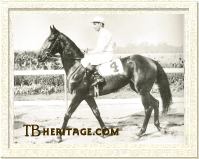
Creole Maid
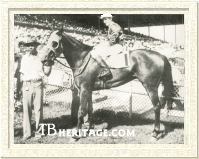
Athenia |
|
Pharamond II's daughter CREOLE MAID (b.f. 1935 out of Baton Rouge by Man O'War) was bred by Walter M. Jeffords and was a younger half-sister to the quality colt Firethorn (by Sun Briar). She was near the top of her division at two, with wins in the Adirondack Handicap and Schuylerville Stakes, beating champion Jacola in the latter, but ran second to her in the Selima Stakes, and also third in the Matron. At three, she won the C.C.A. Oaks, beating champion Handcuff quite handily, and was second in the Gazelle Stakes (to Invoke) and Test Stakes. Creole Maid retired with four wins in 19 starts and $20,950. As a broodmare, she produced the Travers Stakes winner Natchez (1943 by Jamestown), became the granddam of stakes winner Tender Size, and third dam of Admiral's Voyage (dam's sire of Danzig).
A close relative to Menow, ATHENIA (dk.b.f. 1943 out of Salaminia by Man O'War) she was the first foal out of Menow's half-sister Salaminia. Also bred by H.P. Headley at Beaumont Farm, she won 10 races in 31 starts and $105,710. Her best year was at three, when she won the Misty Isle Stakes, Cleopatra Handicap, Artful Handicap and Ladies Handicap, besides placing in the Kentucky Oaks, New York Handicap and Jerome Handicap. At four, she was stakes-placed once at Keeneland. |
As a broodmare, Athenia gained more lasting fame. Although she produced the Washington Park Futurity winner Georgian (1952 by Revoked), it was one of her four stakes-placed runners that carried the line forward, the filly Attica (1953 by Mr. Trouble), who became the dam of the champion, Derby winner, and important sire Sir Ivor.
A few other daughters of Pharamond II became important broodmares, including Menow's sisters HIPPARETE (dam of Pillow Talk, Rash Statement and Out Talk) and LITHE (dam of Supple, granddam of Gentle King and What a Gent); also IRISH NORA (dam of champion three-year-old filly Kiss Me Kate), PELISSE (dam of Pellicle), DEAR VIRGINIA, MISS DRUMMOND, and BLINKING OWL (third dam of Alysheba and Lear Fan)
Pharamond II lived out his days at Beaumont Farm at the edge of Lexington and was destroyed there in September of 1952 at the age of 27, buried in an unmarked grave. In the 1950s, Hal Price Headley sold large portions of Beaumont for development, and the location of the Beaumont stallion barns and paddocks is now in housing, offices, and a shopping center along Harrodsburg Road. Although he lies virtually forgotten under the sod of the Beaumont neighborhoods, Pharamond II's influence is deeply entrenched in the American Thoroughbred. His male line descendants Buckpasser, Spend A Buck, Lil E. Tee, and Silver Charm have kept his line alive. Buckpasser was one of this country's great runners in the 1960s and became a tremendously important broodmare sire. The latter three were all winners of the Kentucky Derby.
--Anne Peters
|
|
|
|

